If you’re using Google Analytics 4 (GA4) on your Shopify store, you’ve probably noticed something feels off.
Some purchase data are missing in your reports.
Purchase data doesn’t match what you see in Shopify.
Google Ads conversions aren’t lining up — or not showing at all.
And while many merchants try to fix these issues with tag tweaks or manual GTM updates, the real solution often requires a deeper understanding of:
How Shopify’s platform handles events
What GA4 actually needs for attribution
And how to work around the growing limitations of browser-based tracking
The Most Common Shopify GA4 Tracking Issues (and Why They Happen)
Tracking issues on Shopify aren’t just technical glitches — they’re often the result of how Shopify’s architecture interacts (or fails to interact) with GA4’s data requirements.
Let’s break down the most common problems — and why they happen:
❌ Missing Purchase Events in GA4
GA4’s purchase event relies on client-side scripts firing successfully on the “thank_you” page — but in many cases, this doesn’t happen.
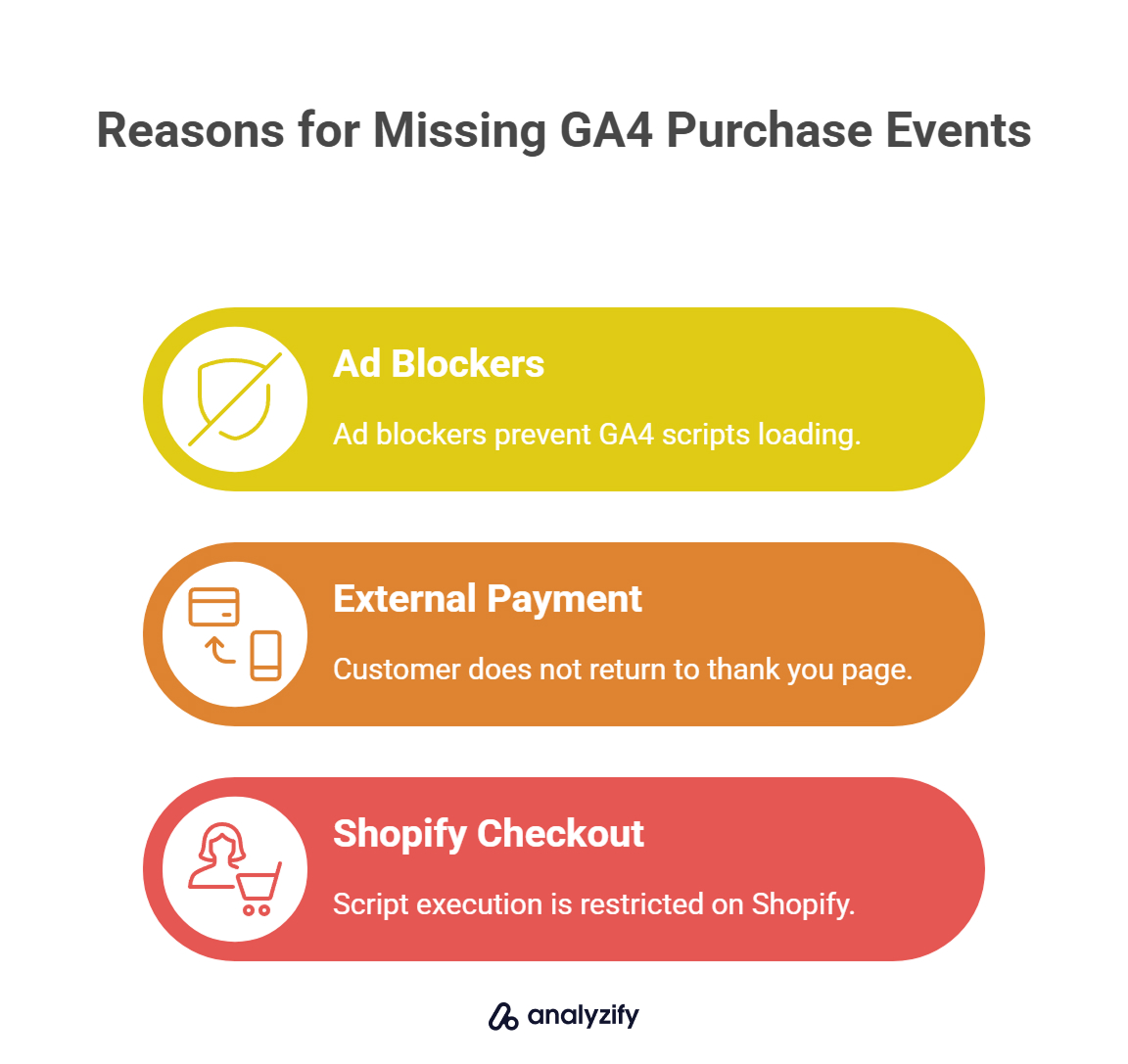
Why it fails:
Ad blockers or browser settings (especially on iOS/Safari) may prevent GA4 scripts from loading at all.
If the customer uses an external payment provider, they may never return to the thank_you page.
Shopify’s newer checkout structure (via Checkout Extensibility) restricts script execution — making it harder to guarantee the event is triggered.
❌ GA4 Revenue Doesn’t Match Shopify
You see purchase events in GA4, but the total revenue is lower than what Shopify reports.
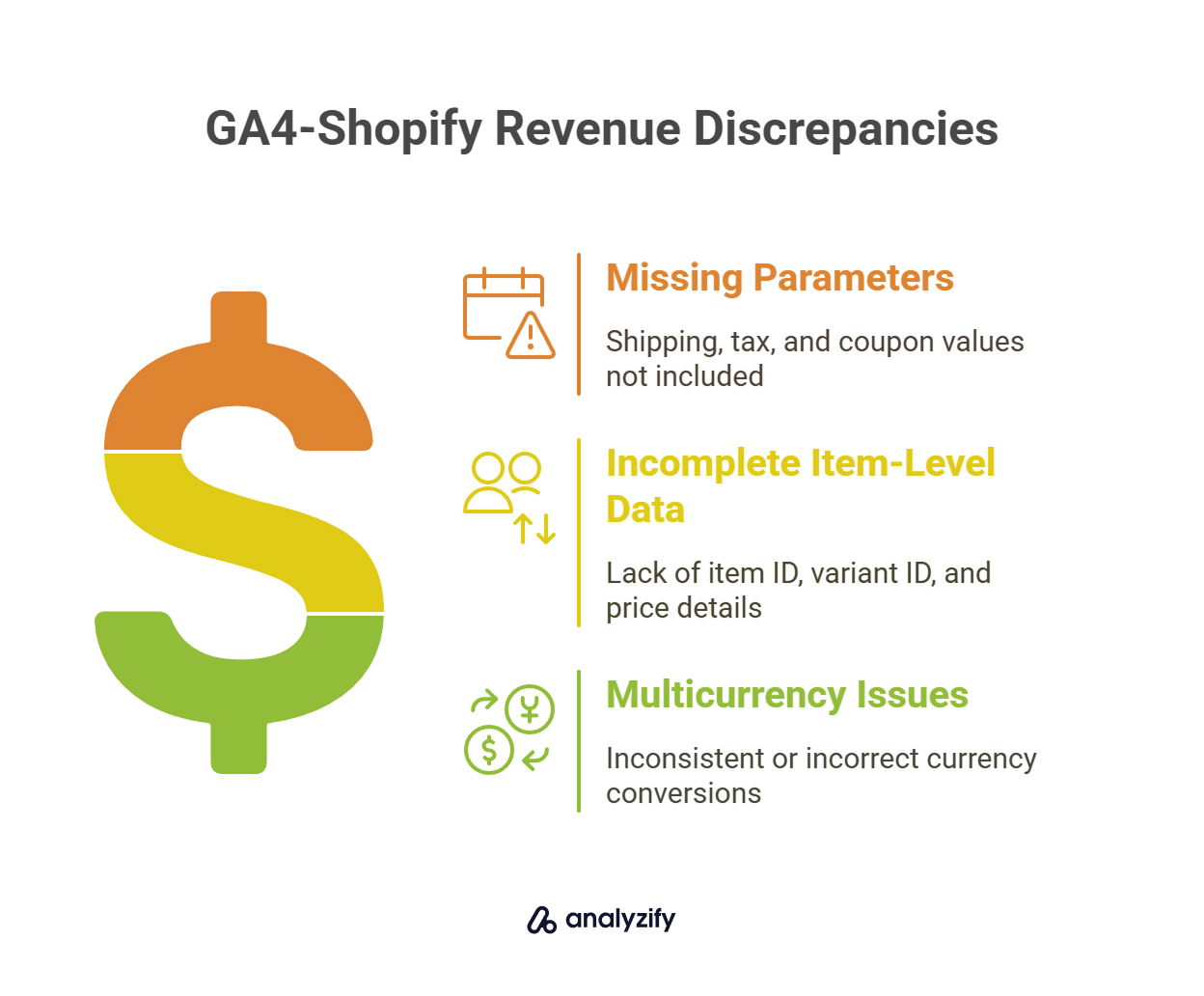
Why it fails:
Missing parameters: Shipping, tax, and coupon values aren’t included unless explicitly passed in the event.
Incomplete item-level data: Many setups fail to send item-level details (item ID, variant ID, price), which can skew totals.
Multicurrency issues: If Shopify Markets is used, the reported currency in GA4 might be inconsistent or converted incorrectly.
❌ Attribution Is Lost — Shows “Direct / None” Instead of Campaigns
You’re running ads or email campaigns — but conversions appear in GA4 as “direct / none.”
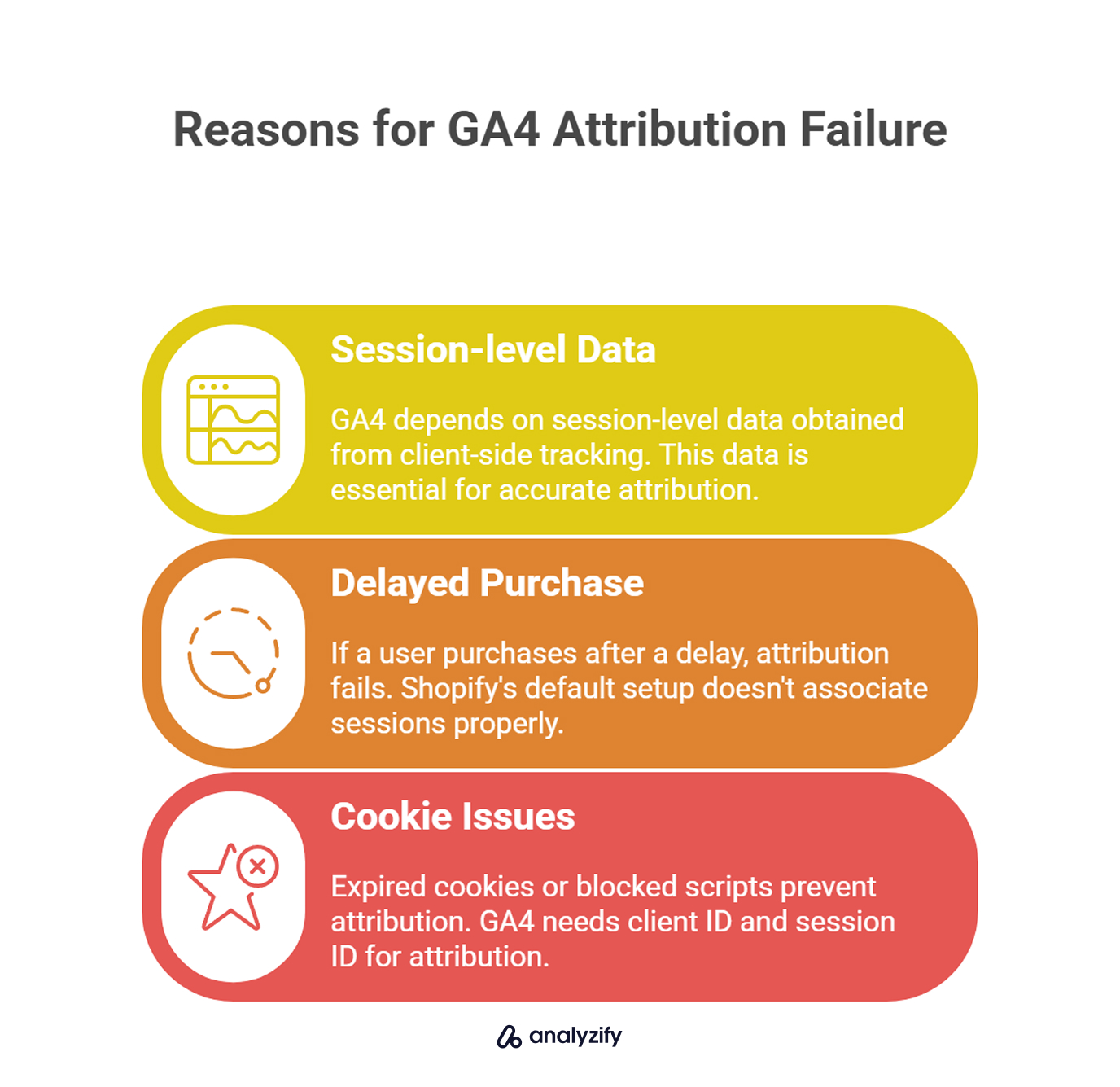
Why it fails:
GA4 relies on session-level data, which comes from browser-side (client-side) tracking.
If the user completes the purchase after a delay, or from another device, Shopify’s default setup doesn’t associate the session properly.
Expired & modified cookies or blocked scripts mean GA4 doesn’t receive the client ID or session_id needed for attribution.
Bonus: Learn more about Why Your Attribution Data Doesn’t Match Across Platforms
❌ Google Ads and Meta Conversions Don’t Register
You’re seeing sales in Shopify — but no matching conversions in Google Ads or Meta Ads.
![]()
Why it fails:
These platforms require timely and properly formatted events for conversion matching.
url_passthrough not enabled in Google Consent Mode, which prevents Google Ads from linking clicks (gclid) to conversions
Relying only on client-side tracking (e.g., Meta Pixel), which is blocked by iOS privacy restrictions and browser settings
 Built for Shopify - No Dev Work Required - Fast Setup
Built for Shopify - No Dev Work Required - Fast Setup 
Standart Tracking Methods Aren't Enough for Shopify
Let Analyzify combine client-side and server-side tracking. So you capture every important event, even when browser script fail.Even When It Works, Shopify’s GA4 Setup Misses Key Data
Let’s say your GA4 setup seems to be working — events are firing, and purchases are showing up in your reports. That doesn’t mean you’re getting the full picture.
Shopify’s GA4 integration — through the Google & YouTube Channel — only tracks a limited subset of events and parameters. It may look functional, but it lacks the depth required for reliable reporting, optimization, and remarketing.

It skips over critical parts of the customer journey
By default, Shopify’s native setup doesn’t send many standard GA4 ecommerce events, including:
view_cart
remove_from_cart
add_shipping_info
view_item_list
select_item
add_contact_info
add_address_info
Without these events, it becomes much harder to analyze where users drop off in the funnel or why certain products are frequently abandoned.
It also misses valuable order-level details
Even when a purchase is tracked, key parameters like coupon codes, discount amounts, shipping methods, and product-level identifiers (e.g. SKU, variant ID) often go unreported.
This leaves your reports incomplete and limits your ability to:
Build meaningful segments
Analyze product or collection-level performance
Optimize based on shipping or discount behavior
Analyzify solves this by tracking:
coupon_code, discount_value, and shipping_tier
payment_type and shipping_method
product_id, variant_id, SKU, and even custom ID formats (selectable by you)
![]()
Analyzify also supports multiple ID formats — letting you choose between Product ID, SKU, or variant ID depending on your reporting and remarketing needs.
These enhanced parameters are included by default in key events like purchase, begin_checkout, view_item, and more — making your GA4 setup truly actionable.
Bonus: Learn more about Why You Need Server-Side Tracking for Shopify in 2025
Micro-conversions and engagement signals? Not included.
Shopify’s native setup doesn’t track smaller but important actions — such as form submissions, newsletter signups, user logins, wishlist interactions, or product page engagement.
Analyzify tracks many of these by default and gives merchants the flexibility to set up additional custom events, without writing any code.
Bottom line: Even if your GA4 setup is “working,” the native integration leaves out crucial events and data.
With Analyzify, you get a far more complete picture — helping you make smarter decisions, build better audiences, and improve campaign performance.
How Server-Side Tracking Solves Shopify’s GA4 Problems
Even with a proper GA4 setup, Shopify’s platform introduces tracking gaps that client-side scripts alone can’t fully solve.
Server-side tracking offers a more reliable solution by sending purchase data directly from Shopify to GA4 — without relying on the user’s browser behavior or third-party scripts.
Bonus: Explore Comprehensive Shopify Server-Side Tracking Guidebook covering implementation strategies, first-party data, and solutions for all tracking limitations.
Here’s how it solves the most critical Shopify + GA4 tracking issues:
✅ Captures Purchases That Browser Scripts Miss
In a standard GA4 setup, purchases are tracked when the user lands on the thank_you page.
But if the customer:
Pays through an external provider (e.g., PayPal, Klarna)
The browser is closed before GA4 scripts can execute
Completes a delayed checkout (e.g., via link or email)
![]()
…the GA4 purchase event may never fire.
Server-side tracking doesn’t depend on page views or script execution. It captures the order directly from Shopify’s database once it’s created — even if payment isn’t completed yet — and sends it to GA4 through scheduled server-side jobs. This ensures the transaction is recorded reliably, even when browser-side scripts fail.
✅ Avoids Ad Blockers and Script Failures
Ad blockers, privacy tools, and browser restrictions (especially on iOS) often block GA4 scripts from running.
That means events like purchase or view_item may be completely suppressed, even though the action occurred.
![]()
Because server-side tracking sends data from Shopify’s backend to GA4 via the Measurement Protocol, it bypasses the browser entirely.
So even if the customer uses Safari with strict settings or has an ad blocker enabled, your purchase event still makes it into GA4.
✅ Tracks Events Without Relying on the Thank You Page
Shopify’s newer checkout system (Checkout Extensibility) has a sandboxed environment, which limits how and when scripts can run.
That makes it even harder to rely on browser-based triggers during checkout.
Server-side tracking doesn’t need the thank_you page at all.
Once an order is completed in Shopify, it’s logged, processed, and sent to GA4 directly — with no dependency on the front end.
✅ Enables Consent-Aware & GDPR-Compliant Tracking
Analyzify supports Google Consent Mode v2 (Advanced) and Shopify’s Customer Privacy API — enabling GDPR-compliant tracking without relying on browser scripts alone.
![]()
Data is only sent when valid consent is detected, and Analyzify ensures that server-side tags behave accordingly — following Google’s latest Consent Mode v2 specifications.
The result: You stay compliant with GDPR and regional privacy laws, while maintaining visibility into purchase data whenever tracking is allowed.
✅ Tracks Draft Orders, Subscriptions, and Manual Flows
GA4 purchase events only fire for standard online checkout flows.
But many merchants use:
Subscription renewals (triggered by apps or billing systems)
Manual payment flows via email or link
Client-side GA4 tracking can’t detect these.
But Analyzify’s server-side solution listens directly to Shopify’s order system — capturing and sending these orders to GA4 as confirmed purchases.
✅ Keeps Attribution Alive with Client-Server Matching
One of the most valuable features of Analyzify’s server-side tracking is client-server coordination.
It stores the user’s client_id during the session and attaches it to the server-side event — allowing GA4 to correctly attribute purchases to the original source or campaign, even if the browser flow was broken or delayed.
Bonus: Learn more about Benefits of GA4 Server-Side Tracking for Shopify!
Analyzify — The Fastest Way to Fix GA4 Tracking on Shopify
If you’re struggling with broken GA4 tracking, missing purchases, or inconsistent attribution, you don’t need to rebuild everything from scratch.
Analyzify provides a complete, server-side tracking solution — built specifically for Shopify and GA4.
Here’s how it works:
Up to 98% Accuracy for Purchase Events in GA4
Analyzify tracks purchases directly from Shopify’s backend — not the thank_you page.
This eliminates the most common causes of tracking failure and results in 98%+ accuracy for purchase event reporting in GA4.
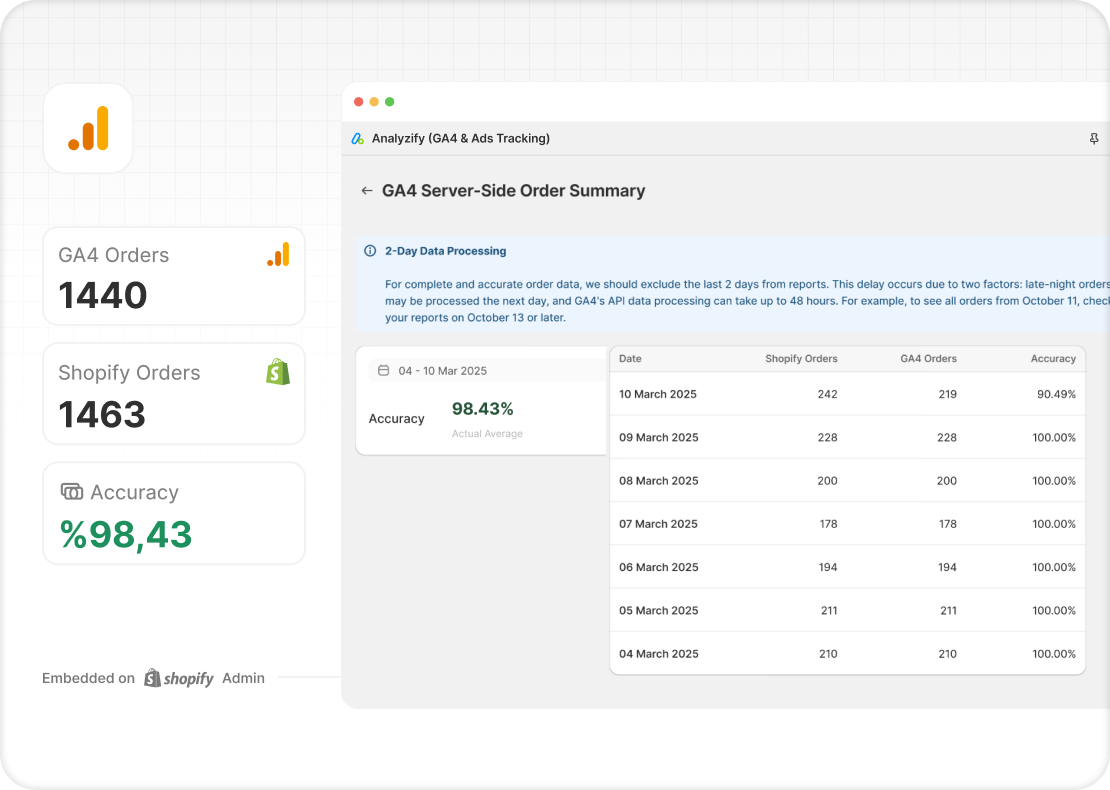
Consent-Ready with Google Consent Mode & Privacy API
Analyzify is fully compatible with Google Consent Mode v2 (Advanced) and Shopify’s Customer Privacy API.
It ensures data is only sent when proper marketing consent is detected — using Google’s Advanced consent model and respecting Shopify’s built-in privacy signals.
This setup helps Shopify merchants meet GDPR and other regional privacy requirements without losing essential purchase tracking when consent is granted.
 Shopify-Native, GDPR-Ready, Consent Mode Supported
Shopify-Native, GDPR-Ready, Consent Mode Supported 
Compliant & Clear, Consent-Based Tracking That Works
Analyzify helps you capture accurate GA4 and ad data - while fully respecting consent preferences and legal boundaries3) Server-Side Purchase Tracking Without Google Cloud Setup
No need to host your own server or manage a GCP account.
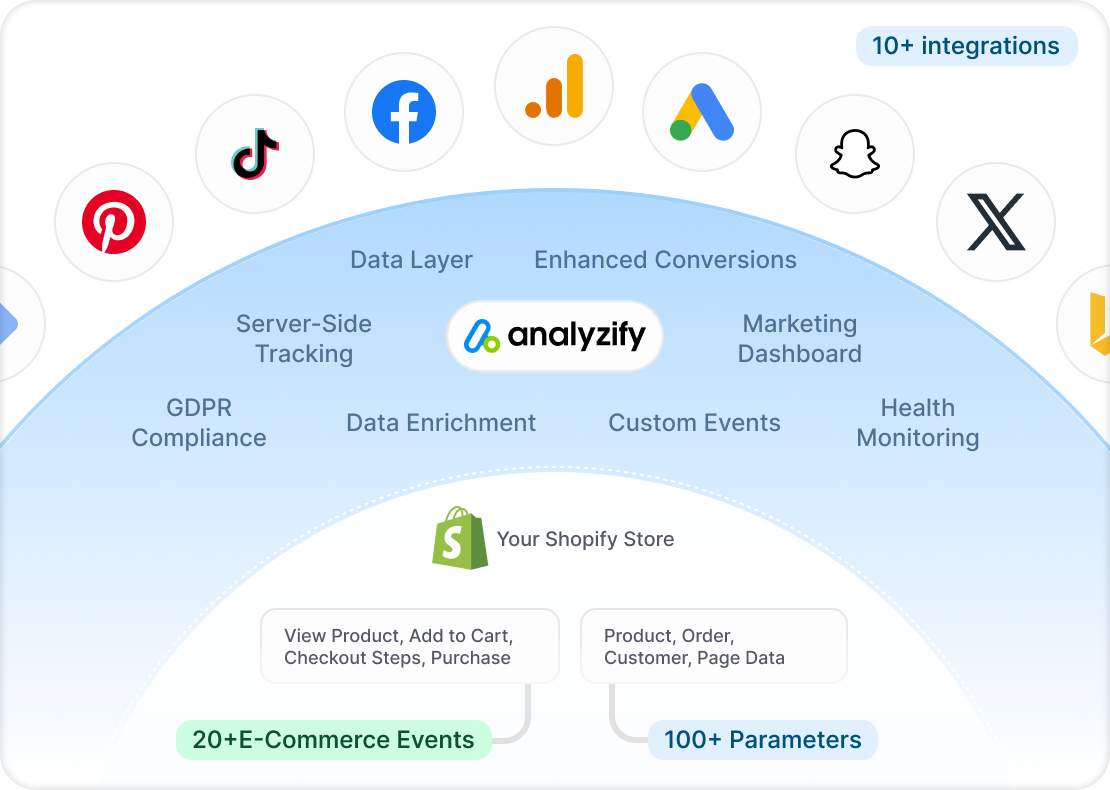
Analyzify provides fully managed server-side tracking with:
Built-in GTM Server container
Purchase events sent via Measurement Protocol
No monthly cloud costs or maintenance required
Bonus: Explore how to Fix Your GA4 & Meta Tracking!
Works with Both Standard and Complex Checkout Flows
Analyzify tracks:
Standard online purchases
Draft Orders (manual B2B or offline sales)
Orders completed through payment links or delayed flows
![]()
And it keeps your attribution alive by attaching the correct client_id — so GA4 knows where the purchase came from.
Built for Shopify. Managed by Experts.
This isn’t a generic solution. Analyzify is purpose-built for Shopify merchants, with:
Seamless GA4 integration
Automatic hybrid setup (client + server)
Ongoing updates, tag maintenance, and support
Bonus: Learn more about
Final Thoughts: Stop Losing Data. Fix Your GA4 Tracking on Shopify.
Google Analytics 4 is powerful — but on Shopify, it’s also fragile.
If your setup relies only on browser-based (client-side) tracking, you’re likely losing valuable purchase and attribution data every day. That’s not GA4’s fault. It’s the result of how Shopify handles checkout, cookies, and user flows.
When that happens, you end up with:
Revenue numbers that don’t match
Purchases that disappear from GA4 reports
Ads that can’t be attributed to actual sales
Server-side tracking solves these problems — and Analyzify makes the fix simple.
Instead of relying on scripts that can break or be blocked, Analyzify tracks purchases directly from Shopify’s backend to GA4. You get:
Up to 98% accuracy for purchase events in GA4
Support for Draft Orders, manual flows, and subscription renewals
Proper Consent Mode handling for GDPR compliance
No Google Cloud setup or manual maintenance — we handle it for you
If you’re running paid campaigns, trying to scale, or just want to trust your numbers again, fixing your GA4 tracking is no longer optional.
👉 Fix Your GA4 Tracking Now
 Built for Shopify - No Dev Work Required - Fast Setup
Built for Shopify - No Dev Work Required - Fast Setup 
Start Tracking Shopify Orders Accurately!
Let Analyzify's enhanced server-side tracking provide you with more accurate & reliable attribution data - setup in 10-15 minutes.Or, if you’re comparing options:
See how Analyzify stacks up against a custom Google Cloud server-side setup
































